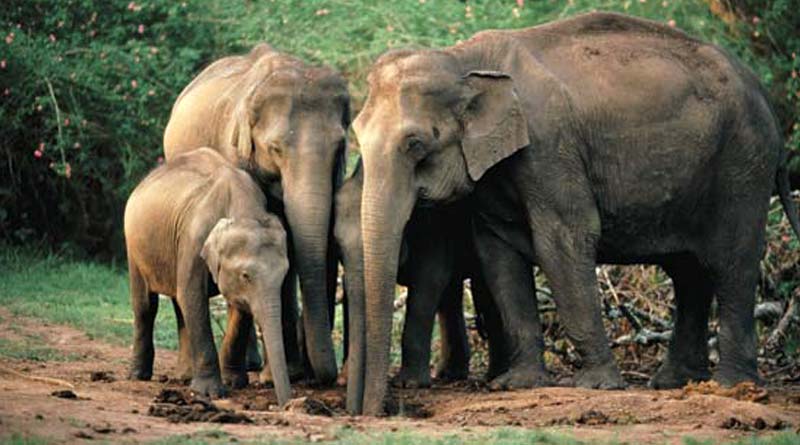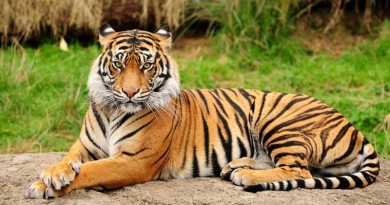Asian Elephant
Asian Elephants are the continent’s largest terrestrial mammals. They can reach 6.4m in length and 3m at the shoulder, and weigh as much as 5 tonnes. They are smaller than African Elephants and have proportionally smaller ears, which they keep in constant motion in order to cool themselves. They also have a single ‘finger’ on the upper lip of their trunks as opposed to African Elephants, which have a second one on the lower tip. Their skin ranges from dark grey to brown, with patches of pink on the forehead, the ears, the base of the trunk and the chest. Unlike the African Elephants, the female Asian Elephant very rarely have tusks, and if the female Asian Elephant does have tusks, they are generally barely visible and can only be seen when the female Asian Elephant opens her mouth.
There are three subspecies of Asian Elephant – the Indian, Sumatran and Sri Lankan. The Indian has the widest range and accounts for the majority of the remaining Elephants on the continent. The Sri Lankan is physically the largest of the subspecies, and also the darkest in colour. The Sumatran is the smallest.
Elephant ears radiate heat to help keep these large animals cool, but sometimes that isn’t enough. Elephants are fond of water and enjoy showering by sucking water into their trunks and spraying it all over themselves.
An Elephant’s trunk is actually a long nose with many functions. It is used for smelling, breathing, trumpeting, drinking, and also for grabbing things—especially a potential meal. The trunk alone contains about 100,000 different muscles. Asian Elephants have a fingerlike feature on the end of their trunk that they can use to grab small items. (African Elephants have two.)
Asian Elephants are herbivorous animals meaning that they only eat plants and plant matter in order to gain all of the nutrients that they need to survive. Elephants need to eat an average of 150 kg per day to survive. They can spend more than two thirds of each day feeding on grasses. But they also devour large amounts of bark, roots, leaves and stems. Cultivated crops such as bananas, rice and sugarcane are also favored foods – sometimes bringing them into conflict with humans. They need to drink at least once a day so they are always close to a source of fresh water.
Female Asian Elephants are generally able to breed by the time they are 10 years old, and give birth to a single Asian Elephant calf after a 22 month gestation period. When the Asian Elephant calf is first born, it weighs about 100 kg, and is cared for not only by it’s mother by also by other female Asian Elephants in the herd (known as aunties). The infant Asian Elephant remains with its mother until it is around 5 years old and gains its independence, with males often leaving the herd and female calves staying. In the wild, Asian Elephants may live up to about 60 years but most do not live that long.
Asian Elephants live in large blocks of forest near water sources and grasslands, habitat that has been greatly reduced in the last half century. They inhabit India, Nepal, Bhutan, Bangladesh, Sri Lanka, Myanmar, Thailand, Laos, Cambodia, Vietnam, China, Malaysia, and Indonesia. Today, the Asian Elephant is considered an endangered species with only around 50,000 left in the wild. This is due to the loss of habitat of the Asian Elephant and illegal poachers hunting the Asian Elephant, for their skins and ivory. The Asian Elephant is listed as endangered on the World Conservation Union’s (IUCN’s) Red List of Threatened Animals.
Asian Elephants have been domesticated for thousands of years. The powerful beasts have been employed to move heavy objects, such as felled trees, to carry humans on their backs, and even to wage war. Asian Elephants are well known for their immense strength and friendliness towards humans.
Key Facts:
- The Asian Elephant is smaller than it’s African cousin.
- It does not have the large ears and hollow back that the African Elephant has.
- It has four nails on each of it’s hind feet while it’s African counterpart has three.
- The Asian Elephant has a lower lip at the tip of it’s trunk unlike the two equal-sized lips of the African Elephant.
- Asian Elephants can tear down trees or pick up a blade of grass with their trunks.
- Male Elephants have large tusks and females generally have none.
- Generally Elephants give birth to only one calf every two to four years.
- A calf remains in the womb for 20 to 22 months.
- Elephants have the largest brain of any land mammal. In fact, of all land mammals, they have the greatest volume of cerebral cortex available for cognitive processing.
- Asian Elephants communicate via rumbles, bellows, and moans. They also emit low-frequency infra-sounds that can travel several miles.
- Along with dolphins and great apes, Asian Elephants are the only animals known to recognize themselves in a mirror.
- In Bangladesh, the Asian Elephant can be found in the wild in the Chunati Wildlife Sanctuary, the Teknaf Game Reserve, their surrounding areas and the Chittagong Hill Tracts.


